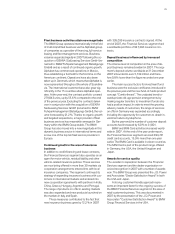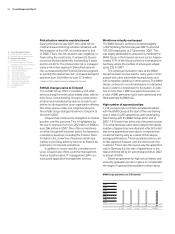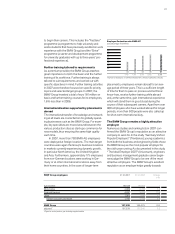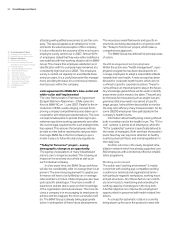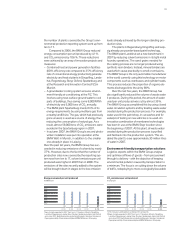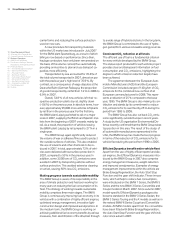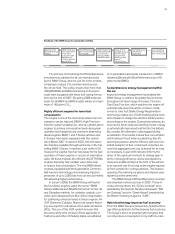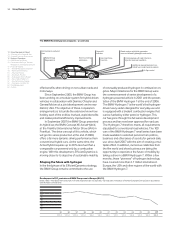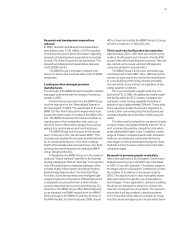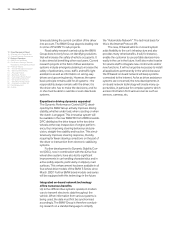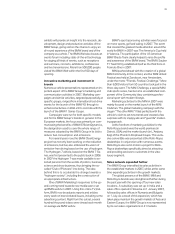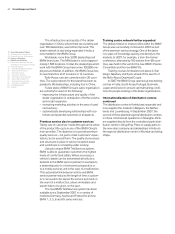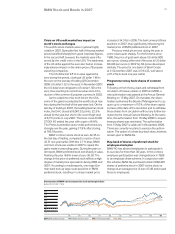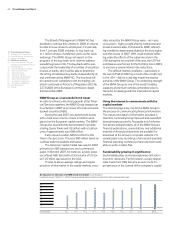BMW 2007 Annual Report Download - page 34
Download and view the complete annual report
Please find page 34 of the 2007 BMW annual report below. You can navigate through the pages in the report by either clicking on the pages listed below, or by using the keyword search tool below to find specific information within the annual report.32 Group Management Report
10 Group Management Report
10 A Review of the Financial Year
13 General Economic Environment
17 Review of Operations
41 BMW Stock and Bonds
44 Disclosures relating to Takeover
Regulations and Explanatory Report
47 Financial Analysis
47 – Internal Management System
49 – Earnings Performance
51 – Financial Position
52 – Net Assets Position
55 – Subsequent Events Report
55 – Value Added Statement
57 – Key Performance Figures
58 – Comments on BMW AG
62 Risk Management
68 Outlook
carrier forms and reducing the surface protection
used on new cars.
A new procedure for transporting materials
within the US market was introduced in July 2007
for the BMW plant Spartanburg, as a result of which
billing is now based on performance. Since then,
haulage contractors have only been remunerated on
the basis of the volume carried, thus automatically
providing an incentive to plan and use transport ca-
pacities more efficiently.
Transportation by sea accounted for 76.8 % of
the total volume transported in 2007, almost on par
with the previous year’s high level of 76.9 %. By
contrast, as a consequence of wage disputes at the
Deutsche Bahn (German Railways), the proportion
of goods transported by rail fell from 7.2 % in 2006 to
6.9 % in 2007.
Overall, 54.8 % of all new vehicles left their
re-
spective production plants by rail, slightly down
(– 0.6 %) on the previous year. In absolute terms, how-
ever,
approximately 95,000 more vehicles left plants
by rail than in the previous year. For the first time,
the BMW plant Leipzig switched to rail on a major
scale in 2007, supplying the British and Spanish
mar-
kets from the beginning of 2007 onwards mainly by
rail. As a result, the proportion of vehicles leaving
the BMW plant Leipzig by rail jumped to 27 % in a
single year.
The BMW Group again significantly reduced
the volume of wax or adhesive films used to protect
the outside surfaces of vehicles. This also enabled
the use of solvents and other chemicals to be re-
duced in 2007. In total, approximately 72 % of vehi-
cles were delivered without surface protection in
2007, compared to 53 % in the previous year. In
addition, some 3,500 tons of CO2 emissions were
avoided in 2007 by transporting vehicles without
surface protection. This avoided extensive cleaning
on arrival, causing 80 % less CO2 emissions.
Making progress towards sustainable mobility
The BMW Group is aware of its responsibility in the
area of climate protection and has been working for
many years on reducing the fuel consumption of its
fleet. The strategy of working towards sustainable
mobility comprises three main stages. The BMW
Group is continuously improving fuel economy in its
vehicles with a combination of highly efficient engines,
optimised energy management, innovative light-
construction
design and improved aerodynamics. In
the medium term, the BMW Group is working on
achieving additional fuel economy benefits by various
measures, from electrification of the drivetrain through
to a wide range of hybrid solutions. In the long term,
the BMW Group is committed to the use of hydro-
gen gained from various renewable energy sources.
Consistent CO2 reduction at all levels
The efficient use of fuel is a fundamental criterion
for every vehicle developed by the BMW Group.
The status report produced for each vehicle project
provides clear and transparent information on fuel
consumption and CO2 emissions, highlighting the
degree to which emission reduction targets have
been achieved.
The agreement between the European Auto-
mobile Manufacturers (ACEA) and the European
Commission included a target of 140 g/km of CO2
emissions for the combined new car fleet of all
European car manufacturers for 2008. This repre-
sents a reduction of 25 % compared to the base
year, 1995. The BMW Group is also making its con-
tribution and stands by its commitment to reduce
CO2 emissions for its own fleet by 25 % during the
period from 1995 to 2008.
The BMW Group has also cut back CO2 emis-
sions significantly outside Europe in recent years.
A study by the US organisation Environmental De-
fense recently confirmed that the BMW Group takes
top position in this area. The result of the study: of
all auto mobile manufacturers represented in the
USA, the BMW Group has made the best progress
in terms of the reduction of CO2 emissions for its
vehicle fleet during the period from 1990 to 2005.
EfficientDynamics benefit entire vehicle fleet
Apart from the use of highly efficient petrol and die-
sel engines, the EfficientDynamics measures intro-
duced by the BMW Group in 2007 also comprise
energy management measures, weight reduction
and improved aerodynamics. Examples of energy
management improvements within the vehicle are
Brake Energy Regeneration, the Auto Start Stop
Function and the gear shift indicator. These innova-
tions, which all help to reduce fuel consumption,
were introduced on the BMW 1 Series, the BMW 5
Series and the new BMW 3 Series Convertible and
Coupé models in March 2007. Since autumn 2007,
model-specific EfficientDynamics packages also
became standard in the BMW 3 Series Sedan, the
BMW 3 Series Touring and the X models as well as in
the revised BMW 6 Series Coupé and Convertible
models. All MINI models apart from the convertible
have been fitted with Brake Energy Regeneration,
the Auto Start Stop Function and the gear shift indi-
cator since autumn 2007.





